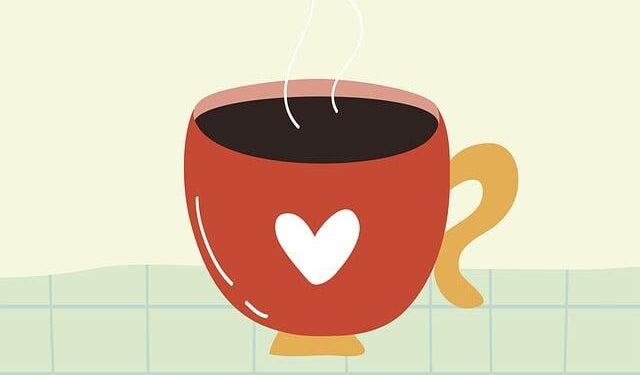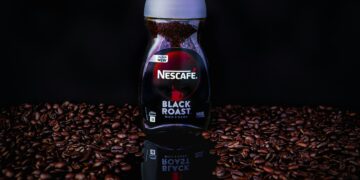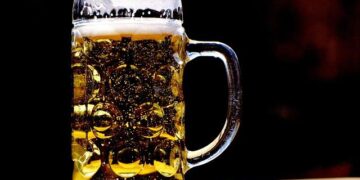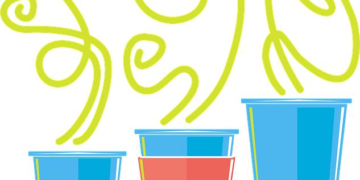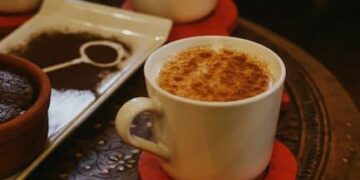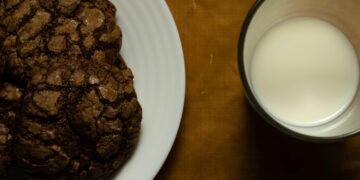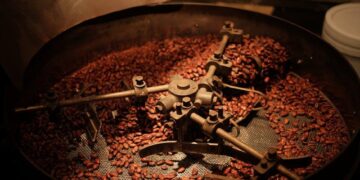Table of Contents
An Introduction to the Caffè Mocha
Defining the Beverage: A Compositional and Historical Overview
The Caffè Mocha, often referred to as a mocaccino, stands as a popular and indulgent fixture on coffee shop menus worldwide.
At its core, it is a chocolate-flavored variant of the caffè latte, a beverage built upon the foundational elements of espresso and steamed milk.1
While preparation can vary, a standard mocha is typically composed of approximately one-third espresso and two-thirds steamed milk, with the defining characteristic being the integration of a chocolate component.3
This chocolate element can be introduced as a syrup, a powder, or even melted chocolate shavings, and the final drink is commonly served hot, often garnished with a layer of whipped cream.4
The flavor profile of a mocha is a carefully orchestrated balance between the inherent bitterness of the espresso and the rich sweetness of the chocolate.
This combination yields what is often described as a velvety, smooth, and luxurious beverage that appeals to both coffee aficionados and those with a preference for sweeter confections.2
Variants on the classic formula exist, most notably the White Caffè Mocha, which substitutes white chocolate for the traditional milk or dark chocolate, creating a distinct flavor profile.1
The historical lineage of the term “mocha” adds a layer of complexity to its modern identity.
The name does not originate from the recipe itself but from a geographical location: the port city of Al Mokka in Yemen.2
For centuries, this port was the global epicenter for the trade of a specific type of coffee bean, the Mocha bean, which was celebrated for possessing a naturally rich and chocolate-like flavor profile.3
The original “mocha coffee” was thus defined by the unique
terroir and characteristics of these Yemeni beans.
However, the contemporary caffè mocha has undergone a significant semantic evolution.
The name no longer signifies the use of these specific, historically important beans.
Instead, “mocha” has become a generic descriptor for any coffee beverage to which chocolate flavoring has been added.2
This shift is critical for understanding the beverage’s modern characteristics and its wide range of potential caffeine contents.
By decoupling the name from a specific agricultural origin, the global coffee industry can produce mochas at scale, using any available espresso bean as the base.
This allows for immense standardization in flavor through syrups and powders, but it also introduces significant, often undisclosed, variability in the drink’s primary active ingredient: caffeine.
The modern mocha is a constructed flavor profile, not a direct reflection of a particular coffee bean’s intrinsic qualities.
The Core Caffeinated Components: Espresso and Chocolate
To accurately determine the caffeine content of a mocha, it is essential to deconstruct the beverage into its constituent parts and identify which contribute to its stimulant effect.
A mocha’s caffeine profile is derived from two distinct sources: a primary, high-impact contributor and a secondary, more modest one.
The primary and most significant source of caffeine in any mocha is the espresso that forms its coffee base.5
Espresso is a concentrated coffee preparation that, by its nature, contains a substantial amount of caffeine.
The number of espresso shots used in the drink is the single largest determinant of its final caffeine tally.
Whether a mocha contains one, two, or three shots of espresso will fundamentally define its position on the spectrum from a mild pick-me-up to a powerful stimulant.
The secondary source of caffeine is the chocolate component itself.7
Caffeine is a naturally occurring alkaloid in the cocoa bean, the raw ingredient from which all chocolate is made.
Therefore, whether the mocha is flavored with chocolate syrup, cocoa powder, or melted chocolate, this ingredient will add a certain amount of caffeine to the total.
However, the contribution from the chocolate is typically much smaller than that from the espresso.
Other ingredients in a standard mocha are generally non-caffeinated and serve primarily as diluents.
The steamed milk, which constitutes the largest portion of the drink by volume, contains no caffeine.4
Likewise, any additional sweeteners, such as sugar or non-chocolate flavored syrups, do not contribute to the caffeine load.4
These components affect the beverage’s flavor, texture, and caloric content, and they influence the
concentration of caffeine per ounce, but they do not alter the total number of milligrams of caffeine in the cup.
Therefore, a precise analysis of a mocha’s caffeine content must focus almost exclusively on quantifying the contributions from its two active ingredients: espresso and chocolate.
The Primary Contributor: A Deep Dive into Espresso’s Caffeine Profile
The Science of Espresso Extraction and Caffeine Solubility
Espresso is defined as a concentrated coffee beverage, brewed by forcing a small amount of nearly boiling water, under significant pressure, through finely ground and compacted coffee beans.8
This specific brewing method is what gives espresso its characteristic intensity and crema.
The process is designed for efficiency, extracting a large amount of soluble solids and oils from the coffee grounds in a very short period, typically 20 to 30 seconds.10
Central to this process is the extraction of caffeine, a natural stimulant found in coffee beans.
Caffeine is an alkaloid that is highly soluble in water, particularly hot water.10
The combination of high water temperature (typically between 195°F and 205°F) and high pressure (traditionally 9 bars) in an espresso machine creates an extremely effective environment for dissolving caffeine and pulling it from the coffee grounds into the final liquid shot.10
The efficiency of this extraction means that a small volume of espresso can pack a potent dose of caffeine, making it the undeniable engine of a mocha’s stimulant effect.
Establishing a Baseline: Caffeine Content of a Standard Espresso Shot
To build a model for a mocha’s caffeine content, one must first establish a reliable baseline for its core component.
The “standard” unit of espresso is the single, or solo, shot, which typically measures 1 fluid ounce (approximately 30 ml).8
While the exact caffeine content can fluctuate based on a number of factors, a consensus range has been established through various analyses.
A single 1-ounce shot of espresso contains, on average, between
63 mg and 75 mg of caffeine.8
This figure represents the most frequently cited and reliable average, although the absolute range can be wider, with some estimates as low as 29 mg and others as high as 100 mg per shot, depending on the specific conditions of its preparation.14
In modern coffee shop practice, particularly in large chains like Starbucks, the single shot is often not the default for milk-based beverages.
Most standard-sized drinks, such as a grande latte or mocha, are built on a double shot, also known as a doppio.8
A doppio is approximately 2 fluid ounces and, as expected, contains double the caffeine of a single shot.
This places the typical caffeine content of a standard espresso base for a mocha in the range of
126 mg to 150 mg.8
Understanding this distinction between a single shot and the more common double-shot base is fundamental to accurately calculating the caffeine in a commercially prepared mocha.
Critical Variables Influencing Espresso’s Potency
The average caffeine content of an espresso shot is not a fixed constant but rather a midpoint within a range governed by several critical variables.
For the discerning consumer, understanding these factors is key to comprehending the potential for significant variation from one mocha to the next, even when they appear identical.
The single most impactful variable is the genetic makeup of the coffee bean itself, specifically the choice between the two dominant species: Coffea arabica (Arabica) and Coffea canephora (Robusta).
Robusta beans contain nearly double the caffeine of Arabica beans.9
By mass, Robusta beans are composed of 2.2% to 2.7% caffeine, which translates to approximately 22-27 mg of caffeine per gram of coffee.
In stark contrast, Arabica beans contain 1.2% to 1.5% caffeine, or 12-15 mg per gram.9
While specialty coffee shops often build their reputation on using 100% Arabica beans, prized for their nuanced and aromatic flavor profiles, more commercial or mass-market blends may incorporate Robusta beans.
This is done to increase the perceived “strength” or intensity (often called
crema), boost the caffeine content, and lower the overall cost of the blend.19
The consumer is almost always unaware of this crucial choice, as coffee shops tend to market their espresso based on flavor notes (“rich,” “caramelly”) rather than on the specific Arabica-to-Robusta ratio, which is the primary determinant of the final caffeine payload.
Another key variable is the roast level of the beans.
Contrary to a widespread popular belief that a darker, “bolder” roast is stronger, lighter roasts actually contain slightly more caffeine by weight than dark roasts.12
The roasting process, which develops the flavor of the beans, also causes a slight degradation of caffeine.
Therefore, a bean that is roasted for a longer period to a darker profile will have a marginally lower caffeine content than a bean roasted for a shorter time.12
Finally, the specific parameters of preparation play a role.
A finer grind of coffee increases the total surface area of the grounds exposed to water.
This, combined with a firm tamp (the compression of grounds in the portafilter), can slow the flow of water and lead to a more thorough extraction of all soluble compounds, including caffeine.12
The duration of the extraction, or “pull,” is also a factor.
A
lungo, or long pull, uses more water and a longer contact time than a standard shot, which can increase the total caffeine extracted.14
Conversely, a
ristretto, or short pull, is more concentrated in flavor but may have slightly less total caffeine due to the reduced water volume and contact time.
The Multiplier Effect: How the Number of Shots Dictates Total Caffeine
Once a baseline caffeine value for a single espresso shot is understood, calculating the total caffeine contribution to a mocha becomes a straightforward matter of multiplication.
The total caffeine from the coffee component is simply the caffeine content per shot multiplied by the number of shots used in the beverage.
This multiplier effect is what creates the broad range of potencies available in coffee shops.
A typical progression is as follows:
- Single Shot (Solo): Approximately 63–75 mg of caffeine. This is the base for smaller drinks like a “short” or “tall” at many establishments.8
- Double Shot (Doppio): Approximately 126–150 mg of caffeine. This is the most common foundation for medium-sized (e.g., “grande”) espresso drinks.8
- Triple Shot: Approximately 189–225 mg of caffeine. This is often found in larger iced drinks or can be requested as an addition.8
- Quad Shot: Approximately 252–300 mg of caffeine. A powerful dose, this is typically reserved for very large drinks or for consumers seeking a significant stimulant effect.8
The following table summarizes the key variables that a barista or consumer can control, and their directional impact on the caffeine content of the final espresso shot(s).
| Factor | Higher Caffeine Outcome | Lower Caffeine Outcome | Supporting Sources |
| Bean Type | Robusta Beans | Arabica Beans | 9 |
| Roast Level | Lighter Roast | Darker Roast | 12 |
| Grind Size | Finer Grind | Coarser Grind | 10 |
| Extraction Time | Lungo (Long Pull) | Ristretto (Short Pull) | 14 |
| Number of Shots | More Shots (e.g., Triple, Quad) | Fewer Shots (e.g., Single) | 8 |
This framework demonstrates that while a coffee shop may offer a “mocha,” the underlying caffeine content is far from standardized.
It is a product of agricultural choices, roasting philosophy, and specific preparation techniques, most of which are not immediately apparent to the person ordering the drink.
The Secondary Contributor: Unpacking the Caffeine in Chocolate
Caffeine in Cacao: From Bean to Bar
While espresso provides the primary caffeine punch in a mocha, the chocolate component adds its own, albeit smaller, contribution.
The source of this caffeine is the cocoa bean (or cacao bean), the seed of the Theobroma cacao tree.20
When processed, cocoa beans are separated into two main parts: cocoa solids (also known as cocoa nibs or simply cacao) and cocoa butter (the fatty component).21
Caffeine, along with the related alkaloid theobromine, is found exclusively within the cocoa solids.7
Cocoa butter is naturally caffeine-free.21
This fundamental distinction dictates a direct and predictable correlation:
the amount of caffeine in any given chocolate product is directly proportional to its percentage of cocoa solids.7
Consequently, dark chocolate, which has a high concentration of cocoa solids, contains the most caffeine.
Milk chocolate, which is diluted with milk solids and has a lower percentage of cocoa solids, contains less caffeine.
Finally, white chocolate, which is made from cocoa butter, sugar, and milk solids but contains no cocoa solids, is entirely devoid of caffeine.7
Formulation Matters: Cocoa Powder vs. Chocolate Syrup
The form in which chocolate is added to a mocha significantly impacts its caffeine contribution.
The two most common forms are unsweetened cocoa powder and pre-made chocolate syrup or sauce.
Unsweetened cocoa powder is essentially pure, ground cocoa solids.
As such, it represents one of the most concentrated forms of chocolate caffeine.
A single tablespoon of unsweetened cocoa powder contains approximately 12 mg of caffeine.7
On a larger scale, 100 grams of cocoa powder can contain up to 230 mg of caffeine.21
Mochas made at home or in specialty cafes that use pure cocoa powder will therefore receive a more substantial caffeine boost from their chocolate component.
In contrast, commercial chocolate syrups and sauces, which are prevalent in high-volume coffee chains, are a different formulation entirely.
These products are typically made with some cocoa, but they are heavily diluted with sugar, water, corn syrup, and other flavorings.7
This dilution drastically reduces the concentration of cocoa solids per serving.
Most commercially available chocolate syrups contain only
3 to 4 mg of caffeine per tablespoon.7
This is a critical distinction.
The choice between using pure powder and a diluted syrup can result in a 3-to-4-fold difference in the caffeine contribution from the chocolate alone.
The proprietary “mocha sauce” used by chains like Starbucks falls into this latter category.
Through analysis of their nutritional information, it can be determined that a Starbucks Grande Hot Chocolate, which contains no coffee, is made with four pumps of mocha sauce and has a total of 25 mg of caffeine.26
This allows for a reliable deduction: one pump of Starbucks mocha sauce contributes approximately
6.25 mg of caffeine.26
This is higher than a generic grocery store syrup but still significantly lower than an equivalent amount of pure cocoa powder.
The Spectrum of Chocolate: Dark, Milk, and White Chocolate Variants
The type of chocolate used further defines the caffeine content.
As established, this is a direct function of the cocoa solid percentage.
- Dark Chocolate: Containing the highest percentage of cocoa solids (e.g., 45% to 85%), dark chocolate is the most caffeinated variety. A one-ounce (28g) serving of dark chocolate can contain anywhere from 12 mg to over 23 mg of caffeine, with the amount increasing with the cacao percentage.23
- Milk Chocolate: With a lower concentration of cocoa solids, milk chocolate has a correspondingly lower caffeine content. A one-ounce serving typically contains around 5 to 6 mg of caffeine.7
- White Chocolate: As it contains no cocoa solids, white chocolate is caffeine-free.7 This is an important point for consumers: a “White Chocolate Mocha” derives 100% of its caffeine exclusively from its espresso shots. Ordering a white mocha over a regular mocha is a way to slightly reduce total caffeine intake by eliminating the chocolate’s contribution.3
The following table provides a clear comparison of the caffeine content in these common chocolate ingredients, illustrating the wide range of potential contributions to a mocha’s total caffeine load.
| Chocolate Ingredient | Serving Size | Estimated Caffeine (mg) | Supporting Sources |
| Unsweetened Cocoa Powder | 1 Tablespoon | ~12 mg | 7 |
| Commercial Chocolate Syrup | 1 Tablespoon | 3–4 mg | 7 |
| Starbucks Mocha Sauce | 1 Pump | ~6.25 mg | 26 |
| Dark Chocolate (70-85%) | 1 ounce (28g) | 12–23 mg | 27 |
| Milk Chocolate | 1 ounce (28g) | 5–6 mg | 7 |
| White Chocolate | 1 ounce (28g) | 0 mg | 7 |
Synthesizing the Data: Calculating a Mocha’s Total Caffeine Content
A Predictive Model for Estimating Caffeine
By combining the analyses of the primary (espresso) and secondary (chocolate) contributors, it is possible to construct a predictive model to estimate the total caffeine content of any given mocha.
The calculation is a simple additive formula:
Total Caffeine=(Caffeine per espresso shot×Number of shots)+(Caffeine per serving of chocolate×Number of servings)
This model can be used to verify the stated caffeine content of commercial beverages and to estimate the caffeine in a homemade preparation.
For example, consider a hypothetical Grande-sized (16 oz) mocha from a commercial chain like Starbucks, which is known to use a double shot of espresso and four pumps of mocha sauce in this size.
- Espresso Contribution: Assuming a standard double shot (doppio) of Arabica espresso, the caffeine content is approximately 150 mg (2 shots × 75 mg/shot).13
- Chocolate Contribution: The caffeine from four pumps of Starbucks’ proprietary mocha sauce is approximately 25 mg (4 pumps × 6.25 mg/pump).26
- Estimated Total Caffeine: Adding the two components yields an estimated total of 150 mg+25 mg=175 mg.
This calculated value aligns perfectly with the officially published nutrition information for a Starbucks Grande Caffè Mocha, which is listed as 175 mg.29
This confirms the validity of the model and demonstrates that the total caffeine content is a direct and predictable sum of its parts.
Establishing a Practical Range for a Standard Mocha
Using the predictive model, one can establish a practical range for the caffeine content found in most commercially available mochas.
A low-end estimate, representative of a small or tall (e.g., 12 oz) mocha, would typically involve a single shot of espresso and fewer pumps of chocolate syrup.
- Espresso: 1 shot × ~75 mg/shot = 75 mg
- Chocolate: 2-3 pumps × ~6.25 mg/pump = 12.5–18.75 mg
- Low-End Total: Approximately 87–94 mg. This range is consistent with the reported caffeine content for a Starbucks Tall Caffè Mocha, which is 95 mg.31
A high-end estimate would involve a larger drink, potentially with more espresso shots and perhaps made with a more potent coffee blend (e.g., including Robusta beans).
- Espresso: 3 shots × ~75 mg/shot (Arabica) = 225 mg
- Chocolate: 6 pumps × ~6.25 mg/pump = 37.5 mg
- High-End Total: Approximately 262.5 mg. If the espresso blend included Robusta beans, the caffeine per shot could be closer to 100 mg, pushing the total well over 300 mg.
Based on these calculations and the common practices of major coffee chains (typically using 1-2 shots of espresso and syrup-based chocolate), a standard mocha ordered from a coffee shop will most likely fall within a caffeine range of 90 mg to 185 mg.
Analysis of Hot vs. Iced Mocha Preparations
A crucial point of variation in caffeine content arises when comparing hot and iced versions of the same named drink size, particularly in larger sizes.
The reason for this is twofold: the displacement volume of ice and the corresponding adjustment in the recipe, specifically the number of espresso shots.32
At many chains, including Starbucks, the recipe for espresso shots does not scale linearly with cup volume for hot drinks.
A Grande (16 oz) hot mocha and a Venti (20 oz) hot mocha both contain the same number of espresso shots: two.15
The extra 4 ounces of volume in the hot Venti are filled with additional steamed milk and syrup, not additional coffee.
This means a customer “sizing up” from a Grande to a Venti hot mocha is paying for more milk, not a stronger caffeine kick.
The recipe for iced drinks, however, is different.
An iced Venti cup is larger (24 oz) to accommodate a significant volume of i.e. To maintain a balanced coffee flavor against this extra dilution, the recipe calls for an additional shot of espresso.
Therefore, an iced Venti mocha at Starbucks contains three espresso shots.32
This creates a significant caffeine discrepancy that is not apparent from the menu’s naming convention.
A consumer might logically but incorrectly assume that a “Venti” mocha has a set caffeine level.
In reality, an iced Venti mocha is substantially more caffeinated than its hot counterpart because it contains an entire extra shot of espresso.
This insight reveals that the most effective way for a consumer to increase their caffeine intake is not always to order a larger size (especially for hot drinks) but to explicitly request an additional espresso shot.
This contradicts common consumer behavior, which often equates a larger, more expensive cup with a stronger drink.
The Commercial Landscape: A Comparative Analysis of Major Coffee Chains
The theoretical calculation of a mocha’s caffeine content is best understood when applied to the real-world offerings of major commercial coffee chains.
Each brand has its own proprietary recipes, serving sizes, and formulations, which result in a diverse landscape of caffeine levels.
An analysis of Starbucks, Dunkin’, and McDonald’s reveals that a “mocha” is far from a standardized product.
Case Study: Starbucks Caffè Mocha
Starbucks provides detailed nutritional information, allowing for a precise analysis.
Their Caffè Mocha is made with brewed espresso, milk, and a proprietary “Mocha Sauce,” which contains sugar and cocoa processed with alkali.29
The number of espresso shots is standardized by size:
- Short (8 oz, hot only): 1 shot
- Tall (12 oz): 1 shot
- Grande (16 oz): 2 shots
- Venti (20 oz, hot): 2 shots
- Venti (24 oz, iced): 3 shots 15
The caffeine contribution from the chocolate sauce is approximately 6.25 mg per pump.
The number of pumps also scales with size (e.g., a Grande receives 4 pumps, a hot Venti 5, and an iced Venti 6).
This leads to the following total caffeine content for their hot mochas:
- Short (8 oz): 90 mg 31
- Tall (12 oz): 95 mg 31
- Grande (16 oz): 175 mg 29
- Venti (20 oz): 185 mg 31
It is critical to note the small 10 mg jump from a Grande to a hot Venti.
This is due solely to one extra pump of mocha sauce, not an extra espresso shot, highlighting the diminishing return on caffeine for sizing up hot drinks.
For iced mochas, the caffeine content of a Grande (16 oz) is the same at 175 mg.
However, the Venti (24 oz) iced mocha, with its three espresso shots and six pumps of sauce, contains a significantly higher caffeine load, estimated at approximately 262.5 mg (225 mg from espresso + 37.5 mg from chocolate).
Starbucks’ ready-to-drink (RTD) bottled mochas show further variation.
A 9.5 fl oz bottled Frappuccino contains between 70 mg and 90 mg of caffeine, while a larger 13.7 fl oz version contains 105 mg.34
Case Study: Dunkin’ Mocha Beverages
Dunkin’s mocha offerings are typically sold as a “Mocha Latte” or a “Mocha Swirl” added to another coffee beverage.
The company’s reporting on espresso shots is less transparent than Starbucks’.
Some sources suggest that their latte machines dispense a single, size-portioned shot, making direct comparison difficult.36
However, third-party analysis of their lattes provides a strong baseline.
The estimated caffeine content for an in-store Dunkin’ Mocha Latte is based on their standard latte figures:
- Small (10 oz, not 16): 118 mg 37
- Medium (14 oz, not 16): 166 mg 37
- Large (20 oz): 252 mg 37
The mocha swirl syrup itself is expected to add only a negligible amount of caffeine.
Where Dunkin’ stands out is in its RTD products.
The Dunkin’ Bottled Mocha Iced Coffee is a high-caffeine formulation.
A single 13.7 fl oz bottle contains 186 mg of caffeine.38
This is notably more caffeine than their medium in-store mocha latte, despite being a similar volume.
This highlights a crucial point for consumers: the caffeine content of a brand’s RTD product cannot be assumed to mirror its in-store, barista-made counterpart.
The formulation for a shelf-stable product is often different, engineered for a specific and consistent energy profile.
Another product, the canned “Shot in the Dark” Mocha, which is an espresso-coffee blend, contains
128 mg in a smaller 8.1 fl oz can.41
Case Study: McDonald’s McCafé Mocha
McDonald’s does not officially publish the caffeine content of its beverages, stating that the FDA does not require it.42
Therefore, all available figures are based on third-party testing and estimates.
The McCafé Mocha is made with espresso and chocolate syrup.
- A small McCafé Mocha is estimated to contain 86 mg of caffeine.43
- A medium (16 oz) hot McCafé Mocha is estimated to contain 167 mg.14
- The medium (16 oz) McCafé Iced Mocha is also estimated at 167 mg, making it one of the most caffeinated options on the McDonald’s beverage menu.14
- The McCafé Mocha Frappe contains less caffeine, with a small size having around 100 mg.43
The following table provides a standardized, at-a-glance comparison of the mocha offerings from these three major chains, focusing on the common medium/grande (~16 oz) size to facilitate a direct assessment.
| Brand | Beverage | Size | Estimated Caffeine (mg) | Key Notes and Sources |
| Starbucks | Caffè Mocha (Hot or Iced) | Grande (16 fl oz) | 175 mg | Contains 2 espresso shots plus caffeine from mocha sauce. 29 |
| Dunkin’ | Mocha Latte (Hot or Iced) | Medium (14 fl oz) | ~166 mg | Caffeine content based on standard latte; smaller volume than 16 oz. 37 |
| Dunkin’ | Bottled Mocha Iced Coffee | 13.7 fl oz | 186 mg | High-caffeine RTD formulation. 38 |
| McDonald’s | McCafé Mocha (Hot or Iced) | Medium (16 fl oz) | 167 mg | Third-party estimate. 14 |
Contextualizing Caffeine: The Mocha vs. Other Beverages
Mocha vs. Latte and Cappuccino: A Question of Chocolate
When comparing a mocha to its closest relatives, the latte and the cappuccino, the defining factor is the chocolate.
Within the same coffee shop and for the same serving size, all three beverages are typically built on the exact same foundation: an identical number of espresso shots.5
A Grande Latte, a Grande Cappuccino, and a Grande Mocha at Starbucks all start with two shots of espresso.
Therefore, the base caffeine level from the coffee is identical across all three.
A Grande Latte at Starbucks contains 150 mg of caffeine, derived entirely from its two espresso shots.30
The
only difference in the mocha is the small, additional amount of caffeine contributed by the chocolate sauce.
In the case of a Grande Mocha, the four pumps of sauce add approximately 25 mg of caffeine, bringing the total to 175 mg.29
This makes a mocha consistently and predictably, albeit slightly, more caffeinated than a latte or cappuccino of the same size from the same establishment.
Mocha vs. Drip Coffee: Deconstructing the “Strength” Misconception
One of the most pervasive misconceptions in coffee culture is the idea that espresso-based drinks are inherently “stronger” in caffeine than regular drip-brewed coffee.11
This belief stems from the sensory experience: espresso’s concentrated nature gives it an intense, powerful flavor that consumers equate with strength.
However, when measured in total milligrams of caffeine, this perception is often incorrect.
The key is the difference in volume.
While espresso has a much higher concentration of caffeine per ounce (around 63 mg/oz) compared to drip coffee (around 12-15 mg/oz), a standard serving of drip coffee is significantly larger (typically 12-20 oz) than a serving of espresso (1-2 oz).8
The total caffeine content is a function of both concentration and volume.
A direct comparison makes this clear:
- A Starbucks Grande (16 oz) Caffè Mocha contains 175 mg of caffeine.29
- A Starbucks Grande (16 oz) Pike Place Roast drip coffee contains 310-330 mg of caffeine.11
The conclusion is unambiguous: a standard medium-sized cup of drip coffee from a major chain like Starbucks often contains nearly double the total caffeine of a mocha of the exact same volume.
This illustrates the critical need for consumers to distinguish between the sensory perception of flavor strength and the physiological reality of caffeine content.
A mocha is a flavor-forward beverage, but in terms of pure stimulant load, it is often surpassed by a simple cup of brewed coffee.
Broader Comparisons: Tea, Soft Drinks, and Energy Drinks
To provide a complete picture for the health-conscious consumer, it is useful to place the mocha’s caffeine content on a broader spectrum of commonly consumed beverages.
This contextualization allows for better management of total daily caffeine intake.
The following table benchmarks a standard Starbucks Grande Mocha (175 mg) against other popular drinks.
It clearly shows that a mocha is a moderately to highly caffeinated beverage, far exceeding soft drinks and teas, but falling short of the high levels found in large drip coffees.
| Beverage | Serving Size | Estimated Caffeine (mg) | Supporting Sources | ||
| Starbucks Grande Caffè Mocha | 16 fl oz | 175 mg | 29 | ||
| Starbucks Grande Pike Place Coffee | 16 fl oz | 310–330 mg | 11 | ||
| Dunkin’ Bottled Mocha Iced Coffee | 13.7 fl oz | 186 mg | 38 | ||
| Standard Espresso Shot | 1 fl oz | 63–75 mg | 8 | ||
| Black Tea | 8 fl oz | 25–50 mg | 45 | ||
| Can of Coca-Cola Classic | 12 fl oz | 34 mg | 47 | ||
| Red Bull Energy Drink | 8.4 fl oz | ~80 mg | 48 | ||
| Decaf Coffee | 8 fl oz | 2–15 mg | 13 |
This comparative data empowers the consumer to make informed substitutions.
For instance, one Grande Mocha contains the caffeine equivalent of roughly five cans of Coca-Cola or more than two Red Bull energy drinks.
Conversely, it contains only about half the caffeine of a Grande drip coffee from the same location.
Conclusion: An Informed Approach to Mocha Consumption
Summary of Key Findings
This comprehensive analysis reveals that the caffeine content of a caffè mocha is a predictable yet highly variable quantity, determined by a confluence of agricultural, formulation, and preparation factors.
The total caffeine in a standard 16-ounce (grande) mocha typically falls within the range of 165 mg to 185 mg.
The key findings of this report are as follows:
- Dual-Source Contribution: A mocha’s caffeine comes from two sources: the primary contributor is the espresso shot(s), and the secondary contributor is the chocolate component.
- Espresso is Dominant: The vast majority of the caffeine (typically 85-90%) is derived from the espresso. The total caffeine is dictated primarily by the number of shots used.
- Critical Variables: The caffeine in the espresso base is subject to significant variation based on undisclosed factors, most notably the use of high-caffeine Robusta beans versus lower-caffeine Arabica beans. Lighter roasts and finer grinds can also increase caffeine extraction.
- Chocolate’s Role: The caffeine from chocolate is modest but not negligible. Preparations using unsweetened cocoa powder contribute more caffeine (~12 mg/tablespoon) than those using diluted commercial syrups (~3-6 mg per serving/pump). A White Chocolate Mocha contains no caffeine from its chocolate component.
- Brand Disparity: There is no industry standard for a “mocha.” A medium-sized mocha from Starbucks (175 mg), Dunkin’ (~166 mg), and McDonald’s (167 mg) have comparable, but not identical, caffeine levels. Ready-to-drink bottled versions can have significantly different caffeine contents than their in-store counterparts.
- Context is Crucial: A mocha is slightly more caffeinated than a same-size latte or cappuccino due to its chocolate content. However, it is significantly less caffeinated than a standard drip-brewed coffee from many major chains.
Actionable Recommendations for the Caffeine-Conscious Consumer
Armed with this detailed understanding, consumers can move beyond simply ordering a “mocha” and begin to make targeted choices to align their beverage with their personal caffeine preferences and limits.
- To Decrease Caffeine Intake:
- Size Down: Order a “short” (8 oz) or “tall” (12 oz) size. These sizes are typically made with only one espresso shot, immediately cutting caffeine by about half compared to a “grande.”
- Go Decaf or Half-Caf: Request that the mocha be made with decaffeinated or half-decaffeinated espresso shots. This will dramatically reduce the primary caffeine source while maintaining the drink’s fundamental flavor.
- Choose White Chocolate: Opt for a White Chocolate Mocha. Since white chocolate is caffeine-free, this eliminates the secondary caffeine contribution, resulting in a slightly less caffeinated beverage than a traditional mocha.
- To Increase Caffeine Intake:
- Add a Shot: The most direct and cost-effective way to increase caffeine is to request an additional shot of espresso in any size drink.
- Order a Large Iced Version: At chains like Starbucks, ordering a large iced mocha (e.g., an iced Venti) will typically include an extra espresso shot compared to its hot counterpart, providing a significant caffeine boost.
- General Best Practices:
- Be Brand-Aware: Recognize that caffeine levels are not standardized across the industry. Use the comparative data in this report to select a brand whose standard offering meets your needs.
- Distinguish Flavor from Potency: Do not assume that a rich, dark, or “strong” taste equates to high caffeine content. A large cup of mild-tasting drip coffee is often a more potent stimulant than a rich-tasting mocha.
- Always Check the Label: For any ready-to-drink (RTD) bottled or canned mocha, consult the nutrition label for a precise caffeine count. Formulations for these products are engineered for consistency and may differ substantially from in-store preparations.
By applying these strategies, the consumer can transform from a passive recipient into an active participant in the creation of their beverage, ensuring that every mocha they enjoy is perfectly tailored to their desired taste and stimulant effect.
Works cited
- en.wikipedia.org, accessed August 3, 2025, https://en.wikipedia.org/wiki/Caff%C3%A8_mocha
- What is Mocha Coffee | Mocha Origin and Differences | Nescafé IN – Nescafe, accessed August 3, 2025, https://www.nescafe.com/in/coffee-culture/knowledge/mocha
- What is a mocha coffee? | Nescafé UK &IE – Nescafe, accessed August 3, 2025, https://www.nescafe.com/gb/coffee-culture/knowledge/what-is-a-mocha
- What is a Mocha? – Folgers Coffee, accessed August 3, 2025, https://www.folgerscoffee.com/coffee/articles/what-is-a-mocha
- What Is a Mocha? A Guide to the Popular Coffee Drink. – SpotOn, accessed August 3, 2025, https://www.spoton.com/blog/what-is-a-mocha/
- What is Mocha? A 787 Coffee Drinks Explained Guide, accessed August 3, 2025, https://www.787coffee.com/drinks-explained-787-coffee/what-is-mocha
- Does Chocolate Have Caffeine? – INTEGRIS Health, accessed August 3, 2025, https://integrishealth.org/resources/on-your-health/2023/november/does-chocolate-have-caffeine
- Coffee versus Espresso: Unraveling the Caffeine Mystery, accessed August 3, 2025, https://www.compasscoffee.com/blogs/the-daily-grind/coffee-vs-espresso-unraveling-the-caffeine-mystery
- What Coffee Has the Most Caffeine? Strongest Beans & Brews – CAFELY, accessed August 3, 2025, https://cafely.com/blogs/info/what-coffee-has-the-most-caffeine
- Caffeine Myths: Espresso vs Drip – Kicking Horse Coffee, accessed August 3, 2025, https://kickinghorsecoffee.com/pages/caffeine-myths-espresso-vs-drip-coffee
- PSA: Espresso shots honestly aren’t that much caffeine : r/starbucks – Reddit, accessed August 3, 2025, https://www.reddit.com/r/starbucks/comments/kg1ssk/psa_espresso_shots_honestly_arent_that_much/
- How Much Caffeine Is in a Shot of Espresso? – OutIn, accessed August 3, 2025, https://outin.com/blogs/news/espresso-caffeine-content
- How Much Caffeine is in a Shot of Espresso? – CAFELY, accessed August 3, 2025, https://cafely.com/blogs/info/how-much-caffeine-in-espresso-shot
- How Much Caffeine Is in Coffee & Espresso? – The Spruce Eats, accessed August 3, 2025, https://www.thespruceeats.com/how-much-caffeine-in-morning-coffee-765274
- Starbucks Coffee Sizes, Explained | Taste of Home, accessed August 3, 2025, https://www.tasteofhome.com/article/starbucks-coffee-sizes/
- How much caffeine is in a cup of espresso? (Direct From Our Coffee Roaster), accessed August 3, 2025, https://twistedgoatcoffee.com/blogs/espresso/how-much-caffeine-is-in-a-cup-of-espresso
- Arabica vs Robusta Coffee Difference (Mysterious Details Revealed), accessed August 3, 2025, https://balancecoffee.co.uk/blogs/blog/robusta-vs-arabica-coffee
- cafely.com, accessed August 3, 2025, https://cafely.com/blogs/info/what-coffee-has-the-most-caffeine#:~:text=Compared%20to%20arabica%20beans%2C%20which,mg%20per%20gram%20of%20arabica.
- How Much Caffeine is in Coffee? – the Genuine Origin Blog, accessed August 3, 2025, https://blog.genuineorigin.com/2023/01/how-much-caffeine-is-in-coffee/
- How Much Caffeine is in Chocolate, accessed August 3, 2025, https://www.santabarbarachocolate.com/blog/how-much-caffeine-is-in-chocolate/
- Does Cocoa Have Caffeine Like Coffee and Tea? – Tulip Chocolate, accessed August 3, 2025, https://www.tulipchocolate.com/blog/does-cocoa-have-caffeine-like-coffee-and-tea
- Does Chocolate Have Caffeine: White, Dark, and Milk – Healthline, accessed August 3, 2025, https://www.healthline.com/health/does-chocolate-have-caffeine
- Does Chocolate Have Caffeine? The Sweet Truth – FreeRx.com, accessed August 3, 2025, https://freerx.com/Blog/Details?s=%09Chocolate-Have-Caffeine%09
- How much caffeine is in chocolate and cocoa, compared to coffee or tea? – Quora, accessed August 3, 2025, https://www.quora.com/How-much-caffeine-is-in-chocolate-and-cocoa-compared-to-coffee-or-tea
- Is cocoa powder caffeine free? – Quora, accessed August 3, 2025, https://www.quora.com/Is-cocoa-powder-caffeine-free
- What’s the caffeine content of 1 pump of mocha sauce? : r/starbucks – Reddit, accessed August 3, 2025, https://www.reddit.com/r/starbucks/comments/1iaqybw/whats_the_caffeine_content_of_1_pump_of_mocha/
- How Much Caffeine in Chocolate: Sweet Truths Unveiled, accessed August 3, 2025, https://www.coracaoconfections.com/blogs/news/how-much-caffeine-in-chocolate
- Does chocolate have Caffeine: White, Milk, and Dark chocolates – Kron Chocolatier, accessed August 3, 2025, https://www.kronchocolatier.com/blogs/news/does-chocolate-have-caffeine-white-milk-and-dark-chocolates
- Caffè Mocha: Nutrition: Starbucks Coffee Company, accessed August 3, 2025, https://www.starbucks.com/menu/product/408/hot/nutrition
- Coffees Serving Size Caffeine (mg), accessed August 3, 2025, https://deploymentpsych.org/system/files/member_resource/Caffeine%20content%20list.pdf
- How Much Caffeine in a Cup of Starbucks Coffee? – CAFELY, accessed August 3, 2025, https://cafely.com/blogs/info/how-much-caffeine-starbucks-coffee
- How many shots are supposed to be in a venti peppermint mocha? I thought it was supposed to be 3 : r/starbucks – Reddit, accessed August 3, 2025, https://www.reddit.com/r/starbucks/comments/yplb8v/how_many_shots_are_supposed_to_be_in_a_venti/
- How many shots of espresso are in the following sizes? : r/starbucks – Reddit, accessed August 3, 2025, https://www.reddit.com/r/starbucks/comments/imoshn/how_many_shots_of_espresso_are_in_the_following/
- Starbucks Frappuccino – Mocha – 9.5 fl oz – PepsiCo Product Facts, accessed August 3, 2025, https://www.pepsicoproductfacts.com/Home/Product?formula=STARFRAP_M_100203&form=RTD&size=9.5
- Starbucks Frappuccino – Mocha – 13.7 fl oz – PepsiCo Product Facts, accessed August 3, 2025, https://www.pepsicoproductfacts.com/Home/Product?formula=STARFRAP_M_100203&form=RTD&size=13.7
- Breakdown of shots in espresso drinks. : r/DunkinDonuts – Reddit, accessed August 3, 2025, https://www.reddit.com/r/DunkinDonuts/comments/aaxn5e/breakdown_of_shots_in_espresso_drinks/
- How Much Caffeine in Dunkin Frozen Coffee? Content per Brew – CAFELY, accessed August 3, 2025, https://cafely.com/blogs/info/how-much-caffeine-dunkin-frozen-coffee
- Dunkin Donuts Iced Coffee Beverage Mocha Bottle – 13.7 Fl. Oz. – shaws, accessed August 3, 2025, https://www.shaws.com/shop/product-details.960269782.html
- Dunkin’ Rich + Chocolatey Mocha Iced Coffee – 13.7 Fluid Ounce – FRESH by Brookshire’s, accessed August 3, 2025, https://www.freshbybrookshires.com/product/dunkin-mocha-iced-coffee-bottle-id-00049000072389
- Dunkin’ Donuts Mocha Iced Coffee – Cooklist, accessed August 3, 2025, https://cooklist.com/product/dunkin-donuts-mocha-iced-coffee-362934
- Dunkin Donuts, Shot in The Dark – Coffee & Milk Beverage, Mocha (8.1 oz) – Weis Markets, accessed August 3, 2025, https://www.weismarkets.com/shop/product/dunkin-donuts-shot-in-the-dark-coffee-milk-beverage-mocha/510886
- How Strong is a McDonald’s Iced Coffee? Caffeine Content & Facts – CAFELY, accessed August 3, 2025, https://cafely.com/blogs/info/how-much-caffeine-is-in-mcdonalds-iced-coffee
- How Much Caffeine Is In McCafe Drinks? 2025 Breakdown | Corner …, accessed August 3, 2025, https://cornercoffeestore.com/how-much-caffeine-in-mccafe-drinks/
- What Is the Most Caffeinated Drink at McDonald’s? Top 3 Options | Corner Coffee Store, accessed August 3, 2025, https://cornercoffeestore.com/what-is-the-most-caffeinated-drink-at-mcdonalds/
- www.healthline.com, accessed August 3, 2025, https://www.healthline.com/nutrition/caffeine-in-tea-vs-coffee#:~:text=An%20average%20cup%20(220%20ml,less%20caffeine%20than%20green%20tea.
- Is There More Caffeine in Coffee or Tea – OutIn, accessed August 3, 2025, https://outin.com/blogs/news/caffeine-coffee-vs-tea
- How much caffeine is in a Coca-Cola?, accessed August 3, 2025, https://www.coca-cola.com/us/en/about-us/faq-demo/how-much-caffeine-is-in-a-coca-cola
- How Much Caffeine Is in a Can of Coke and Diet Coke? – CAFELY, accessed August 3, 2025, https://cafely.com/blogs/info/caffeine-in-coke
